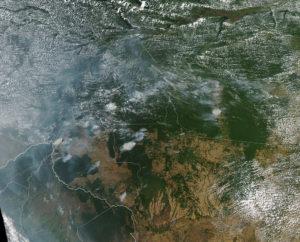Fires in the Amazon threaten ecological resilience
The Amazon rainforest, the world’s largest rainforest, is currently experiencing some of the worst fires in its history. The forest is a vital source of oxygen globally and also absorbs carbon dioxide, making it essential to combating climate change. However, a new government administration in Brazil has prioritized economic growth over environmental policy, making the region more susceptible to disaster and threatening environmental resilience. The forest may soon reach what the World Wildlife Fund refers to as a “tipping point”, where it is no longer able to bounce back and recover from this kind of destruction.

Enabled by the lack of preventative funding, the fires are destroying more than one and a half soccer fields worth of land per minute, according to the National Institute for Space Research (INPE). This is the highest rate since 2013, when the INPE first began tracking. Smoke from the blaze has covered almost half of Brazil, reaching Sao Paulo, more than 1,700 miles away from the fires themselves. The INPE states that the number of fires in 2019 is already 80 percent higher than last year, with poor implications for the environment and ecology of the Amazon.
Political and economic interests have overpowered environmental regulations and policy decisions. Brazil’s current government administration has stressed the need to bolster economic opportunity in the Amazon region. In recent years, the country has become a global leader in soybean production, with agriculture becoming the strongest performing sector of Brazil’s economy. The pressure for increased output has created an incentive to clear more land for planting. This economic priority is evident in changing budgets for environmental agencies. Over the past few years, the Brazilian Environmental and Renewables Institute (IBAMA), the country’s main environmental agency, has seen major budget cuts and reorganization. IBAMA’s budget has been reduced by over $23 million, and has only issued a third of the number of fines that were issued by this time last year. The agency has been left with limited ability to effectively enforce regulations and protect areas like the Amazon, making the forest more vulnerable to activities that can compromise its conservation.
Destruction of the Amazon has both local and global social and environmental effects. The Amazon produces 20 percent of the oxygen in Earth’s atmosphere, and is almost half the size of the United States. However, with fires overcoming the region, there is concern that it may reach a “tipping point”, where the rain-forest transition into a dry savanna that is no longer capable of supporting wildlife. As more forest burns and dies, it is continually replaced by brush and savanna. At its tipping point, the Amazon will be caught in this replacement and the speed of forest loss will increase, making it unable to return to its original state. If this point is reached, the forest could start emitting carbon instead of oxygen and will no longer serve its role in combating climate change. In addition to an environmental impact, the fires will displace some of the millions of indigenous people who reside in the Amazon and they will no longer be able to protect the land from encroaching farmers and loggers. The resilience of these communities, as well as the land they reside in, is weakened by the growing fires.
Sources and Further Reading
Brazil’s Amazon rain-forest is burning at a record rate, research center says – CNN
The Real Reason the Amazon Is On Fire – TIME
Climate Change in the Amazon – World Wildlife Fund
Blame humans for starting the Amazon fires, environmentalists say – CNN
